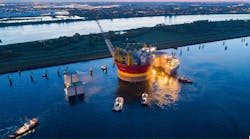David Paganie * Houston
Tension is rising in Europe as the mainland braces for rising energy costs this winter. Consumers are already facing very difficult decisions with electricity costs rising to unaffordable levels. Unfortunately, there are no apparent short-term solutions that will rebalance the market and provide consumers with relief and peace of mind. New energy efficiency measures and government-sponsored programs may help some in the interim, and European nations are actively seeking new suppliers of natural gas. New imports in the form of LNG are the likely long-term solution.
Two regions in particular, North America and the Middle East, have a wealth of natural gas resources that could help offset Europe’s supply deficit. Eastern Mediterranean suppliers could be helpful sources as well, with production in the region expected to reach about 100 bcm/year on the back of new offshore discoveries.
Meanwhile, energy security concerns are adding impetus to expanding renewable development initiatives. Europe is already the leading global market for offshore wind development, and domestic capacity is expected to grow from 26.1 GW at the end of 2021 to about 135 GW by 2030, according to Rystad Energy. The firm forecasts demand for about 8,000 turbines and foundations, 140 offshore substations, and about 33,000 km of inter-array and export cables for projects expected to start up between 2023 and 2030. See Rystad’s full analysis inside this issue’s special report on offshore wind.
View the first annual Offshore Wind Special Report, which includes a comprehensive global industry forecast and review of the challenges, regulatory considerations, and technical solutions for offshore wind development.
On the other side of the pond, developers and suppliers are positioning for a foothold in the US market that is targeting 30 GW from offshore wind by 2030. This translates to $109 billion in private investments for the supply chain, according to the Special Initiative on Offshore Wind (SIOW). This is promising, but the results of upcoming lease sales offshore US west and east coasts and in the Gulf of Mexico will illustrate true market sentiment. View the SIOW report here.
Reliable sources of oil are integral to energy security as well, particularly for nations that rely on imports. To maintain supply, operators are increasingly turning to developments that enable short cycle times and low costs. Since last December, there have been six floating units redeployed, which one prominent market analyst says is the highest level he has ever seen, according to a report by Bruce Beaubouef, Offshore managing editor, inside this issue. Bruce’s article attributes this influx of redeployments to shorter time to first oil (~6-12 months versus much longer conversion timetables), potentially lower costs depending on the condition of the FPU and upgrade requirements, and lower carbon emissions (~70% reduction as compared to new construction).
All sources of energy matter, and offshore has a wealth of untapped resources.





